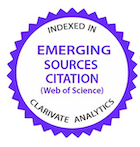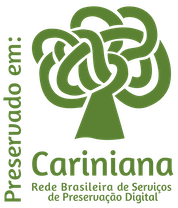Fraturas em ossos longos de Cerdocyon thous: avaliação macroscópica e microestrutural
DOI:
https://doi.org/10.1590/1809-6891v22e-67749Resumo
Teve-se como objetivo, no presente trabalho, realizar a classificação morfológica macroscópica e microestrutural das fraturas em ossos longos de Cerdocyon thous. Foram utilizados 18 cadáveres da espécie, necropsiados e submetidos à avaliação radiográfica e microscópica quando detectadas fraturas em ossos longos. Dentre os 18 animais, oito (44%) possuíam fraturas igualmente distribuídas (33,33%) em fêmur, úmero ou tíbia. Mais frequentemente (61,54%) as fraturas eram simples e acometiam a diáfise, e em menores proporções (23,08%) atingiam a linha fisária. Nas fraturas em diáfise e metáfise, predominava o tecido ósseo cortical, com ósteons longitudinais que continham fibras colágenas longitudinais e intermediárias, e lamelas com aspecto de delaminação. Por outro lado, nas fraturas fisárias, o tecido ósseo trabecular foi mais frequentemente observado, constituído por trabéculas com fibras colágenas desorganizadas e ausência de ósteons. Em ambos os casos, notou-se baixa atividade de osteócitos e baixa cobertura de osteoblastos na superfície óssea. Conclui-se que, nas condições observadas, a frequência de fraturas em ossos longos de C. thous foi de 44%, sendo as fêmeas mais predispostas, além de os achados embasarem a hipótese da ocorrência de tais lesões estarem relacionadas a atropelamentos. O presente estudo contribui significativamente para alertar clínicos e cirurgiões em relação aos tipos de fraturas as quais C. thous está mais predisposto, seus locais de maior ocorrência e sua microestrutura. Dessa forma, surge a necessidade de implementação de ações conjuntas que visem reduzir o número de casos de atropelamento de animais silvestres.
Palavras-chave: Atropelamentos. Biologia óssea. Ortopedia. Traumatologia.
Downloads
Referências
Emmons L, Feer F. Neotropical rainforest mammals: a field guide. 2nd. ed. University of Chicago Press; 1997. Available from: https://doi.org/10.1017/S0376892998250223
Courtenay O, Maffei L. Cerdocyon thous (Linnaeus, 1766). In: Hoffmann M, Sillero-Zubiri C. Canid Action Plan. IUCN Publications, Gland, Switzerland; 2004; 32-37.
de Araujo Cezar HR, Abrantes SHF, de Lima JPR, De Medeiros JB, Abrantes MMR, da Nóbrega Carreiro A, de Lucena Barbosa JP. 2021. Mamíferos silvestres atropelados em estradas da Paraíba, Nordeste do Brasil. Brazilian Journal of Development 2021; 7(3):30694-30698. Available from https://doi.org/10.34117/bjdv7n3-679
Martinelli MM, Volpi TA. Mamíferos atropelados na Rodovia Armando Martinelli (ES-080), Espírito Santo, Brasil. Natureza on line 2011; 9(3):113–116. Available from: http://www.naturezaonline.com.br/natureza/conteudo/pdf/04_martinellimm&volpita_113_116.pdf
Ferreira CM, de Aquino Ribas AC, Casella J, Lucena-Mendes S. Variação espacial de atropelamentos de mamíferos em área de restinga no estado do Espírito Santo, Brasil. Neotropical Biology Conservation 2014; 9(3):125-133. Available from: https://doi.org/10.4013/nbc.2014.93.02
DeCamp, Charles E. Brinker, Piermattei and Flo's handbook of small animal orthopedics and fracture repair. 5th ed. St. Louis, Missouri: Elsevier Health Sciences; 2016. Available from: https://doi.org/10.1016/C2009-0-64185-4
Salter RB, Harris WR. Injuries involving the epiphyseal plate. Jounal of Bone and Joint Surgery 1963; 45(3):587–622. Available from: https://journals.lww.com/jbjsjournal/Citation/2001/11000/Injuries_Involving_the_Epiphyseal_Plate.21.aspx
Müller ME, Koch P, Nazarian S, Schatzker J. Principles of the classification of fractures. In: Müller ME, Nazarian S, Koch P, Schatzker J. The comprehensive classification of fractures of long bones. Berlin: Springer; 1990: 4-7. Available from: https://doi.org/10.1007/978-3-642-61261-9_2
Unger M, Montavon PM, Heim UFA. Classification of fractures of long bones in the dog and cat: introduction and clinical application. Veterinary and Comparative Orthopaedics and Traumatology 1990; 3:41-50. Available from: https://doi.org/10.1055/s-0038-1633228
Morse, A. Formic acid-sodium citrate decalcification and butyl alcohol dehydation of teeth and bones for sectioning in paraffin. Journal of Dental Research 1945; 24(3–4):143–153. Available from: https://doi.org/10.1177%2F00220345450240030501
Ascenzi A, Bonucci E. The compressive properties of single osteons. Anatomical Record 1968; 161(3):377-391. Available from: https://doi.org/10.1002/ar.1091610309
Ayres M, Ayres Júnior M, Ayres DL, Santos ADA. 2007. Aplicações estatísticas nas áreas das ciências bio-médicas. Instituto Mamirauá, Belém, 364
Abd El Raouf M, Ezzeldein SA, Eisa EFM. Bone fractures in dogs: a retrospective study of 129 dogs. Iraqi Journal of Veterinary Sciences 2019; 33(2):401-405. Available from: https://vetmedmosul.com/article_163086_2b07006a0a66c142fbdd156045c601ff.pdf
Keosengthong A, Kampa N, Jitpean S, Seesupa S, Kunkitti P, Hoisang S. Incidence and classification of bone fracture in dogs and cats: a retrospective study at veterinary teaching hospital, Khon Kaen University, Thailand (2013-2016). Veterinary Integrative Sciences 2019; 17(2):127-139. Available from: http://www.vet.cmu.ac.th/cmvj/document/vol.17/number2/2019%2017-2%20%5B21%5D.pdf
Libardoni RDN, Serafini GMC, Oliveira CD, Schimites PI, Chaves RO, Feranti JPS, Costa CAS, Amaral AS do, Soares AV. Appendicular fractures of traumatic etiology in dogs: 955 cases (2004-2013). Ciência Rural 2016; 46(3): 542-546. Available from https://doi.org/10.1590/0103-8478cr20150219
Vidane AS, Elias MZJ, Cardoso JMM, Come JASS, Harun M, Ambrósio CE. Incidência de fraturas em cães e gatos da cidade de Maputo (Moçambique) no período de 1998-2008. Ciência Animal Brasileira 2014; 15(4):490-494. Available from: https://doi.org/10.1590/1089-6891v15i424279
Fighera RA, Silva MCD, Souza TMD, Brum JS, Kommers GD, Graça DL, Irigoyen LF, Barros, CSLD. Aspectos patológicos de 155 casos fatais de cães atropelados por veículos automotivos. Ciência Rural 2008; 38(5):1375-1380. Available from: https://doi.org/10.1590/S0103-84782008000500028
Beale B. Orthopedic clinical techniques femur fracture repair. Clinical Techniques in Small Animal Practice 2004; 19(3):134-150. Available from: https://doi.org/10.1053/j.ctsap.2004.09.006
Kumar K, Mogha IV, Aithal HP, Kinjavdekar P, Singh GR, Pawde AM, Kushwaha RB. Occurrence and pattern of long bone fractures in growing dogs with normal and osteopenic bones. Journal of Veterinary Medicine Series A 2007; 54(9):484-490. Available from: https://doi.org/10.1111/j.1439-0442.2007.00969.x
Bennour EM, Abushhiwa MA, Ben Ali L, Sawesi OK, Marzok MA, Abuargob OM, Tmumen SK, Abdelhadi AW, Abushima MM, Benothman M, Said E, El-Khodery S. A retrospective study on appendicular fractures in dogs and cats in Tripoli-Libya. Journal of Veterinary Advances 2014; 4(3):425-431. Available from: https://www.semanticscholar.org/paper/A-Retrospective-Study-on-Appendicular-Fractures-in-Bennour-Abushhiwa/bb4e483ef8a1d36f65db376dd5a13be3083671c9
Minar M, Hwang Y, Park M, Kim S, Oh C, Choi S, Kim G. Retrospective study on fractures in dogs. Journal of Biomedical Research 2013; 14(3):140-144. Available from: http://dx.doi.org/10.12729/jbr.2013.14.3.140
Siqueira RC, Siragusi RH, Scorsato MF, Souza JB, Franco RP. Estudo retrospectivo da ocorrência de fraturas em ossos longos nos cães atendidos durante o período de 2006 a 2013 na universidade de Marília-SP/Brasil. Revista Portuguesa de Ciências Veterinárias 2015; 10:94-98. Available from: http://www.fmv.ulisboa.pt/spcv/PDF/pdf6_2015/94-98.pdf
Cordey J. Introduction: Basic concept and definitions in mechanics. Injury 2000; 31:1-84. Available from: https://doi.org/10.1016/S0020-1383(00)80039-X
Einhorn TA. Bone strength: The bottom line. Calcified Tissue International 1992; 51(5):333–339. Available from: https://doi.org/10.1007/BF00316875
Turner CH, Burr DB. Basic biomechanical measurements of bone: A tutorial. Bone 1993; 14(4):595–608. Available from: https://doi.org/10.1016/8756-3282(93)90081-K
Junqueira LCU, Carneiro J. Tecido ósseo. In: Junqueira LCU, Carneiro J. Histologia básica. 12th. ed. Rio de Janeiro: Guanabara Koogan; 2013; 131–148.
Jilka RL, Weinstein RS, Parfitt AM, Manolagas SC. Perspective: Quantifying osteoblast and osteocyte apoptosis: challenges and rewards. Journal of Bone and Mineral Research 2007; 22(10): 1492-1501. https://doi.org/10.1359/JBMR.070518
Heřt J, Fiala P, Petrtýl M. Osteon orientation of the diaphysis of the long bones in man. Bone 1994; 15(3):269–277. Available from: https://doi.org/10.1016/8756-3282(94)90288-7
Martin RB,Boardman DL. The effects of collagen fiber orientation, porosity, density, and mineralization on bovine cortical bone bending properties. Journal of Biomechanics 1993; 26(9):1047–1054. Available from: https://doi.org/10.1016/S0021-9290(05)80004-1
Martin RB, Lau ST, Mathews PV, Gibson VA, Stover SM. Collagen fiber organization is related to mechanical properties and remodeling in equine bone. A comparsion of two methods. Journal of Biomechanics 1996; 29(12):1515-1521. Available from: https://doi.org/10.1016/S0021-9290(96)80002-9
Ramasamy JG, Akkus O. Local variations in the micromechanical properties of mouse femur: The involvement of collagen fiber orientation and mineralization. Journal of Biomechanics 2007; 40(4):910–918. Available from: https://doi.org/10.1016/j.jbiomech.2006.03.002
Currey JD. The structure and mechanics of bone. Journal of Materials Science 2012; 47(1):41-54. Available from: https://doi.org/10.1007/s10853-011-5914-9
Hastings Gw, Ducheyne P. Natural and living biomaterials. 1st. ed. Boca Raton: CRC Press; 1984. Available from: https://doi.org/10.1201/9781351074902
Koester KJ, Ager JW, Ritchie RO. The true toughness of human cortical bone measured with realistically short cracks. Nature Materials 2008; 7(8):672–677. Available from: https://doi.org/10.1038/nmat2221
Vashishth D, Behiri JC, Bonfield W. Crack growth resistance in cortical bone: Concept of microcrack toughening. Journal of Biomechanics 1997; 30(8):763–769. Available from: https://doi.org/10.1016/S0021-9290(97)00029-8
Zimmermann EA, Launey ME, Barth HD, Ritchie RO. Mixed-mode fracture of human cortical bone. Biomaterials 2009. 30(29):5877-5884. Available from: https://doi.org/10.1016/j.biomaterials.2009.06.017
Downloads
Publicado
Como Citar
Edição
Seção
Licença
Copyright (c) 2021 Ciência Animal Brasileira

Este trabalho está licenciado sob uma licença Creative Commons Attribution 4.0 International License.
Autores que publicam nesta revista concordam com os seguintes termos:
- Autores mantém os direitos autorais e concedem à revista o direito de primeira publicação, com o trabalho simultaneamente licenciado sob a Licença Creative Commons Attribution que permite o compartilhamento do trabalho com reconhecimento da autoria e publicação inicial nesta revista.
- Autores têm autorização para assumir contratos adicionais separadamente, para distribuição não-exclusiva da versão do trabalho publicada nesta revista (ex.: publicar em repositório institucional ou como capítulo de livro), com reconhecimento de autoria e publicação inicial nesta revista.
- Autores têm permissão e são estimulados a publicar e distribuir seu trabalho online (ex.: em repositórios institucionais ou na sua página pessoal) a qualquer ponto antes ou durante o processo editorial, já que isso pode gerar alterações produtivas, bem como aumentar o impacto e a citação do trabalho publicado (Veja O Efeito do Acesso Livre).






























